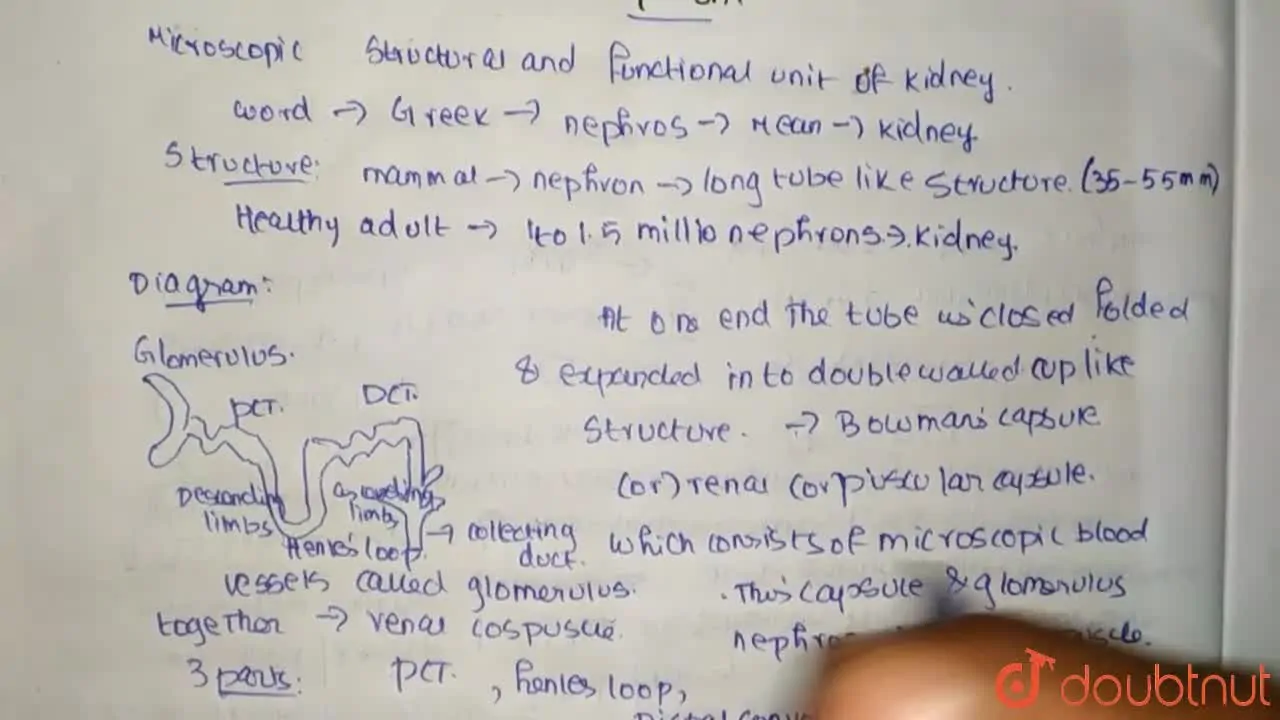Explain the structure of nephron. Solution in Tamil
Each kidney has nearly one million complex tubular structures called nephron. Each nephron consists of a filtering corpuscle called renal corpuscle (malpighian body) and a renal tubule. The renal tubule opens into a longer tubule called the collecting duct. The renal tubule begins with a double walled cup shaped structure called the Bowman.s capsule, which encloses a ball of capillaries that delivers fluid to the tubules, called the glomerulus. The bowman.s capsule and the glomerulus together constitute the renal corpuscle. The endothelium of glomerulus has many pores (fenestrae). The external parietal layer of the Bowman.s capsule is made up of simple squamous epithelium and the visceral layer is made of epithelial cells called podocytes. The podocytes end in foot processes which cling to the basement membrane of the glomerulus. The openings between the foot processes are called filtration slits.

The renal tubule continues further to form the proximal convoluted tubule (PCT) followed by a U-shaped loop of Henle (Henle.s loop) that has a thin descending and a thick ascending limb. The ascending limo continues as a highly coiled tubular region called the distal convoluted tubule (DCT). The DCT of many nephrons open into straight tube called collecting duct. The collecting duct runs through the medullary pyramids in the region of the pelvis. Several collecting ducts fuse to form papillary au that delivers urine into the calyces, which opens into the renal pelvis.
Related Playlists
- BOOK - PREMIERS PUBLISHERSCHAPTER - EXCRETIONEXERCISE - SOLUTION TO TEXTUAL QUESTIONS5videos
EXCRETION
- BOOK - PREMIERS PUBLISHERSCHAPTER - EXCRETIONEXERCISE - CASE STUDY5videos
EXCRETION
- BOOK - PREMIERS PUBLISHERSCHAPTER - EXCRETIONEXERCISE - OTHER IMPORTANT QUESTIONS & ANSWERS (CHOOSE THE CORRECT ANSWER )23videos
EXCRETION
- BOOK - PREMIERS PUBLISHERSCHAPTER - CHEMICAL CO-ORDINATION AND INTEGRATIONEXERCISE - SOLUTION TO TEXTUAL QUESTIONS2videos
CHEMICAL CO-ORDINATION AND INTEGRATION
- BOOK - PREMIERS PUBLISHERSCHAPTER - KINGDOM ANIMALIA EXERCISE - OTHER IMPORTANT QUESTIONS & ANSWERS (Answer the following short answers)1videos
KINGDOM ANIMALIA
Similar Questions
What is the importance of having a long loop of Henle and short loop of Henle in a nephron?
26:30View SolutionBoth the kidneys of Ravi (28 years) were not functioning and he was undergoing dialysis. He was admitted to a hospital with renal failure. His mother Suganthi (47 years) was willing to donate one of her kidneys to her son after she was given counseling. Their blood groups were matching and later approval was obtained from transplant committee and technical committee. Operation was performed for 5 hrs. He was administered with immunosuppressive drugs and anti inflammatory drugs. He recovered from the , operation and returned home.
Name the disease Ravi was suffering from.06:08View SolutionThe ........................ animals can tolerate only narrow fluctuations in the salt concentration.
04:20View SolutionPituitary gland is located in a depression in the sphenoid bone of skull below the brain, so is also called hypothalàmus cerebri. Discuss the following:
(i) Pituitary gland is commonly called "master gland" of the body.06:45View SolutionWrite about the canal system found in Porifera.
03:22View SolutionStructure Of Nephron
05:37View SolutionStructure Of Nephron
06:45View Solutionनेफ्रोन किसे कहते है ? इसका नामांकित चित्र बनाइए व इसकी संरचना को समझाइए ।
06:45View SolutionExplain the structure of nephron.
06:45View SolutionDraw a diagram of a Nephron, and explain its structure.
03:00View Solutionనెఫ్రాన్ నిర్మాణానన్ని పటం సహాయంతో వివరించండి ?
03:32View SolutionExplain the structure of nephron.
02:09View SolutionExplain the structure of nephron.
01:05:51View SolutionExplain the structure of nephron.
01:29:15View SolutionExplain the structure of a nephron with the help of a labelled diagram.
02:20View SolutionExplain the structure of the nephron.
44:52View Solution


